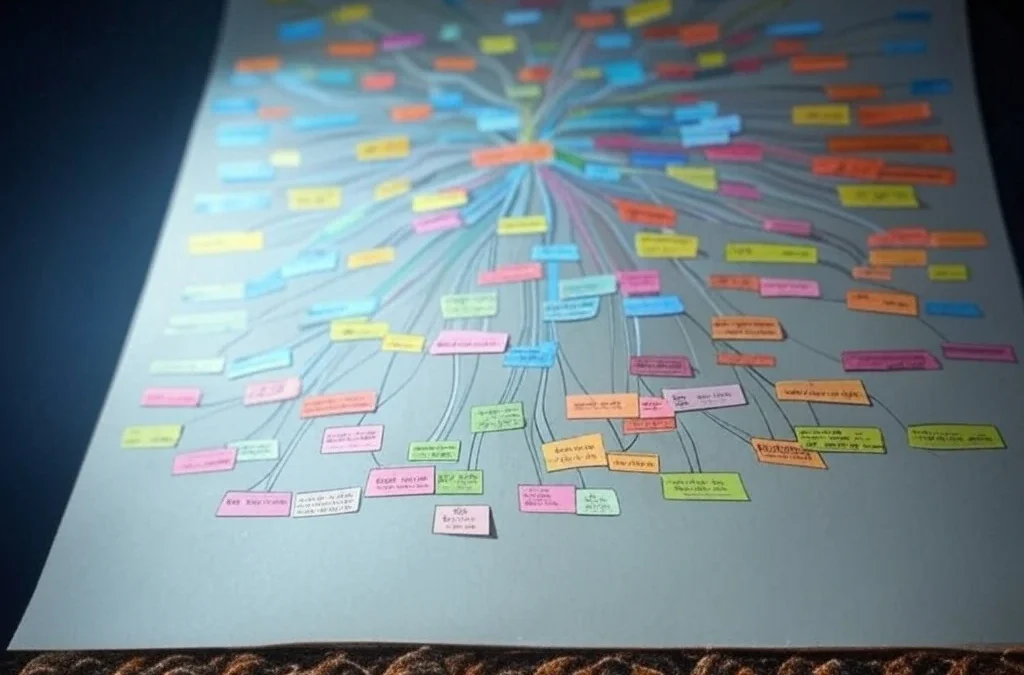Divergent thinking is a powerful mental process that allows us to generate multiple solutions to a single problem. Unlike convergent thinking, which narrows down options to find one correct answer, divergent thinking expands possibilities by exploring numerous pathways and perspectives. This approach to creativity has become increasingly valuable in our complex world, where novel solutions and innovation are highly prized.
When we engage in divergent thinking, we break free from conventional patterns and explore uncharted territories of ideas. This article explores the concept of divergent thinking, provides strategies to develop this skill, and examines how it applies across different fields. We’ll look at real-world applications, address common obstacles, and offer practical exercises to strengthen your divergent thinking muscles.
By understanding and practicing divergent thinking, you can enhance your problem-solving abilities, boost creativity, and discover solutions that might otherwise remain hidden. Let’s explore how this cognitive approach can transform your thinking process and lead to more innovative outcomes.
What Is Divergent Thinking?
Divergent thinking is a thought process that generates creative ideas by exploring many possible solutions. It involves breaking away from established patterns and looking at problems from multiple angles. Unlike convergent thinking, which focuses on finding a single correct answer, divergent thinking seeks to create numerous answers to open-ended questions.
The concept was popularized by psychologist J.P. Guilford in the 1950s as part of his Structure of Intellect model. Guilford identified four key components of divergent thinking:
- Fluency – The ability to produce many ideas quickly
- Flexibility – The capacity to switch between different categories or approaches
- Originality – The generation of unique or unusual ideas
- Elaboration – The development and refinement of ideas with details
Divergent thinking works best when judgment is temporarily suspended. By delaying evaluation and criticism, the mind can freely explore connections and possibilities that might otherwise be dismissed too quickly. This “judgment-free” phase allows for the emergence of truly innovative ideas that can later be refined and developed.
Research suggests that while some people may have a natural inclination toward divergent thinking, it is primarily a skill that can be learned and strengthened through practice. By consciously stepping away from linear thought patterns, anyone can improve their ability to think divergently and tap into greater creative potential.
The Best Examples of Divergent Thinking
Below are 30 of the best divergent thinking examples to help you understand how this creative thinking style works in real situations. Each one shows a different way to generate original ideas, solve problems, or look at things from new angles. You can use these examples to practice and improve your own divergent thinking skills.
1. Inventing Multiple Uses for a Paperclip
Instead of just holding paper, a paperclip could also serve as a zipper pull, jewelry, or even a tiny screwdriver. Divergent thinking involves imagining multiple creative uses for common objects.
2. Creating a Story from Random Words
Pick five unrelated words and make up a short, coherent story. This exercise boosts creativity by connecting unrelated ideas.
3. Designing an Unusual Restaurant Theme
Imagine a restaurant themed around outer space or historical periods. Divergent thinkers explore unconventional ideas rather than typical restaurant themes.
4. Imagining Alternative Endings for Movies
Think of different, unexpected endings for your favorite film. This fosters creativity by challenging expected storylines.
5. Brainstorming Unique Gifts
Coming up with personalized gift ideas that go beyond typical suggestions demonstrates divergent thinking by considering unusual options tailored to the recipient.
6. Inventing New Sports
Combine elements from existing sports to create a completely new game, like soccer played on ice skates. This example highlights creative innovation.
7. Rethinking Transportation Methods
Imagine new ways of commuting, such as flying bicycles or hover shoes, to enhance urban mobility through creative thought.
8. Crafting Original Recipes
Combine unusual ingredients to develop tasty dishes. Divergent thinkers see opportunities where others might see incompatibility.
9. Suggesting Improvements to Everyday Objects
Propose inventive improvements to a toothbrush, like adding a built-in floss dispenser. Divergent thinking improves functionality creatively.
10. Imagining Life on Another Planet
Think vividly about how society might function differently on a distant planet. Divergent thinking broadens perspectives beyond current realities.
11. Alternative Uses for Old Tires
Instead of discarding old tires, visualize turning them into furniture, playground equipment, or flower beds. This shows creative reuse.
12. Developing New Apps
Imagine an app that solves a common but overlooked problem, such as locating lost pets through community alerts. Divergent thinkers identify gaps and possibilities.
13. Drawing Abstract Art
Create artwork without specific objects or realistic themes. Abstract art encourages exploration and unconventional expression.
14. Innovative Fashion Concepts
Design clothing items inspired by architecture or nature, illustrating how divergent thinking connects unrelated domains creatively.
15. Planning Unusual Holidays
Invent new holidays to celebrate unconventional themes, such as “International Left-Handers’ Day,” highlighting originality.
16. Creating Unique Marketing Strategies
Think beyond typical advertising by developing unexpected marketing ideas, like flash mobs or interactive public art installations.
17. Developing Creative Teaching Methods
Teachers who use games, storytelling, or interactive challenges in classrooms exemplify divergent thinking by engaging students differently.
18. Suggesting New Movie Genres
Imagine blending existing genres to form new film types, like “historical comedy horror,” demonstrating creative flexibility.
19. Exploring Unique Architectural Designs
Buildings shaped like animals or everyday objects, such as shoe-shaped houses, reflect divergent thinking in architecture.
20. Inventing Original Musical Instruments
Design instruments combining features from multiple existing instruments, promoting unique musical experiences and creativity.
21. Thinking of New Business Ideas
Invent unconventional businesses like a café-bookstore hybrid or pet gym, showcasing divergent thinking through creative entrepreneurship.
22. Planning Innovative Parties
Throw parties with unique themes, decorations, or activities, such as an “upside-down” party, to creatively engage guests.
23. Imagining New Social Media Platforms
Visualize a platform focused entirely on anonymous compliments or collaborative storytelling, showing originality in digital spaces.
24. Reimagining Public Spaces
Transform typical parks or squares into engaging spaces with interactive art installations or unusual seating arrangements.
25. Inventing Creative Board Games
Design board games with imaginative twists, such as mystery-solving in fantasy worlds, to foster creative gaming experiences.
26. Crafting Original Poetry Forms
Experiment with poetry structures by inventing forms that follow unique, self-created rules, illustrating literary creativity.
27. Unconventional Career Paths
Imagine unique job roles, like “professional dream interpreter” or “urban treasure hunter,” demonstrating creative career thinking.
28. Developing Futuristic Gadgets
Envision gadgets like mind-controlled devices or holographic messaging systems, reflecting imaginative technological advancements.
29. Innovative Problem-Solving Techniques
Solve problems using unexpected methods, such as role-playing or metaphorical thinking, to find original solutions.
30. Creating New Dance Styles
Combine elements of different dance genres or add novel movements to develop entirely new dance forms, celebrating creative expression.
The Science Behind Divergent Thinking
Divergent thinking has strong foundations in cognitive psychology and neuroscience. When we engage in divergent thinking, specific areas of our brain activate in distinctive patterns compared to when we use convergent thinking.
Brain Activity During Divergent Thinking
Studies using functional magnetic resonance imaging (fMRI) show increased activity in the prefrontal cortex during divergent thinking tasks. This brain region is associated with higher-order cognitive functions, including:
- Working memory
- Cognitive flexibility
- Abstract thinking
- Creative problem-solving
Researchers have observed that when people engage in divergent thinking exercises, they often show decreased activity in the executive control network while simultaneously experiencing increased activity in the default mode network. This combination allows the mind to make unusual connections between seemingly unrelated concepts.
The neurotransmitter dopamine also plays a significant role in divergent thinking. Higher levels of dopamine have been linked to greater cognitive flexibility and creative thinking. This helps explain why people often experience creative breakthroughs when they’re relaxed, happy, or in flow states—conditions that naturally boost dopamine levels.
While some anecdotal reports suggest that mild sleep deprivation might occasionally enhance creativity by lowering mental filters, empirical research generally shows that sleep loss impairs divergent thinking abilities. Prolonged tiredness makes it harder for the brain to form and sustain creative connections.
The brain’s neuroplasticity means that regularly practicing divergent thinking strengthens these neural pathways over time, making creative thinking more accessible and natural.
Divergent vs. Convergent Thinking
Understanding the contrast between divergent and convergent thinking helps clarify when and how to apply each approach. These two thinking styles complement each other in the problem-solving process.
Divergent thinking generates options, while convergent thinking evaluates and selects from those options. Both are necessary for effective problem-solving and innovation.
| Divergent Thinking | Convergent Thinking |
|---|---|
| Generates multiple solutions | Identifies the single best solution |
| Open-ended questions | Closed-ended questions |
| “How many ways can we…?” | “What is the correct answer?” |
| Free-flowing and non-linear | Logical and sequential |
| Expansive | Focused |
| Uses lateral connections | Uses vertical reasoning |
| Emphasizes quantity of ideas | Emphasizes quality and accuracy |
| Suspends judgment | Applies critical evaluation |
In real-world problem solving, we typically need both types of thinking. A common pattern is to begin with divergent thinking to explore the full range of possibilities before switching to convergent thinking to analyze, refine, and implement the most promising ideas.
Many creative processes formalize this pattern. For example, the design thinking methodology begins with divergent phases (empathizing and ideating) before moving to convergent phases (prototyping and testing). Similarly, brainstorming sessions often start with a “no criticism” rule to encourage divergent thinking before transitioning to evaluation and selection.
Different people may naturally favor one thinking style over the other.
How to Develop Your Divergent Thinking Skills
Improving your divergent thinking abilities requires regular practice and the creation of mental habits that support creative exploration. Here are practical techniques to strengthen this important skill:
Create a Creativity Routine
Set aside 10-15 minutes daily for creative thinking exercises. Consistency builds neural pathways that make divergent thinking more natural over time. Try to practice at different times of day to discover when your mind is most receptive to creative exploration.
Change Your Environment
Physical surroundings significantly impact thinking patterns. Work in new locations, rearrange your workspace, or simply take a walk outside. Research shows that even moderate changes in environment can stimulate fresh thinking and new perspectives.
Practice Idea Generation Games
Challenge yourself with exercises specifically designed to boost divergent thinking:
- List all possible uses for common objects like paperclips or bricks
- Generate solutions to everyday problems with artificial constraints (e.g., “How would you cook dinner without electricity?”)
- Create word associations by writing down as many related words as possible in two minutes
Expand Your Knowledge Base
Exposure to diverse information creates more material for your brain to connect in unexpected ways. Read books outside your usual genres. Learn about unfamiliar subjects. Connect with people from different backgrounds and fields.
Embrace Constraints
Counterintuitively, limitations often boost creativity. Try solving problems with artificial constraints like “What if I had half the budget?” or “How would this work without technology?” Constraints force your brain to abandon conventional paths and find novel solutions.
Remember that developing divergent thinking takes time. Be patient with yourself and focus on building the habit rather than judging the quality of your ideas initially. With regular practice, you’ll notice improvements in both the quantity and originality of your ideas.
Applications of Divergent Thinking Across Fields
Divergent thinking offers valuable benefits across numerous disciplines and professions. Its application extends far beyond traditional creative fields and has become increasingly important in our complex, rapidly changing world.
Business and Entrepreneurship
In the business world, divergent thinking drives innovation and helps companies adapt to changing markets. Startups use it to identify unmet needs and develop disruptive solutions. Established businesses apply divergent thinking to reimagine products, services, and processes.
Companies like IDEO and Google have formalized divergent thinking in their innovation methodologies. Google’s famous “20% time” policy, which allowed employees to spend one-fifth of their work hours on side projects, led to the creation of Gmail, Google Maps, and other successful products.
Education
Modern educational approaches increasingly incorporate divergent thinking to prepare students for a world where creativity and adaptability are essential. Project-based learning, inquiry-based instruction, and makerspaces all foster divergent thinking skills.
Educators find that students who develop strong divergent thinking abilities:
- Show greater engagement with learning materials
- Demonstrate improved problem-solving skills
- Develop stronger critical thinking abilities
- Show more resilience when facing challenges
Science and Research
Scientific breakthroughs often result from divergent thinking. When researchers question established theories, combine insights from different fields, or apply methodologies in novel ways, they open paths to discovery.
Some of history’s most significant scientific advances came from divergent thinking. Alexander Fleming’s discovery of penicillin resulted from noticing an unexpected pattern—mold killing bacteria—and exploring its implications rather than dismissing it as contamination.
Art and Design
Creative fields naturally employ divergent thinking. Artists and designers regularly generate multiple concepts before refining their vision. Design thinking methodology explicitly incorporates divergent thinking phases where teams generate numerous ideas before converging on solutions to develop.
Medicine and Healthcare
Healthcare professionals increasingly use divergent thinking to address complex patient needs. Interdisciplinary teams bring multiple perspectives to difficult cases, generating comprehensive treatment approaches. Medical researchers apply divergent thinking when exploring new treatment options or repurposing existing medications for new conditions.
As these examples show, divergent thinking provides value across virtually all human endeavors. Its versatility makes it one of the most important cognitive skills to develop in our increasingly complex world.
Overcoming Barriers to Divergent Thinking
While divergent thinking offers tremendous benefits, several common barriers can limit our creative potential. Recognizing and addressing these obstacles is essential for developing stronger divergent thinking abilities.
Fear of Judgment
The most significant barrier to divergent thinking is fear of being judged. When we worry about how others will evaluate our ideas, we self-censor and stick to safe, conventional thinking.
To overcome this:
- Start by practicing divergent thinking privately before sharing with others
- Find supportive environments where wild ideas are welcomed
- Remember that quantity matters more than quality in the initial stages
- Separate idea generation from idea evaluation
Functional Fixedness
This cognitive bias limits us to thinking about objects only in their traditional uses. It prevents us from seeing alternative possibilities and novel applications.
To break functional fixedness:
- Deliberately list alternative uses for familiar objects
- Practice “first principles thinking” by breaking things down to their fundamental properties
- Ask “What else could this be?” when looking at everyday items
Premature Evaluation
Many of us habitually evaluate ideas immediately, killing potentially valuable concepts before they have a chance to develop. This habit shuts down the divergent thinking process too early.
Try these techniques to delay evaluation:
- Use timed sessions designated specifically for generating ideas without judgment
- Write down all ideas without filtering—even those that seem silly or impractical
- Practice the “yes, and…” approach from improvisational theater
- Set a minimum quota for ideas (e.g., “I must list 20 possibilities before evaluating any”)
Stress and Time Pressure
While mild stress can sometimes enhance creativity, intense pressure and tight deadlines typically constrict thinking. Under significant stress, the brain favors familiar patterns over novel connections.
To manage this barrier:
- Build buffer time for creative thinking into projects
- Use relaxation techniques before divergent thinking sessions
- Break large tasks into smaller components with adequate time for exploration
- Recognize when you’re in “survival mode” thinking and consciously shift to more open thinking
By recognizing and addressing these barriers, you can create conditions that allow divergent thinking to flourish. With practice, these obstacles become easier to overcome, leading to richer creative experiences and more innovative outcomes.
Practical Exercises to Strengthen Divergent Thinking
Regular practice is key to developing stronger divergent thinking skills. These exercises are designed to be simple yet effective, requiring minimal time and resources while providing maximum benefit for your creative development.
The Random Word Challenge
- Select a random word (use a dictionary, random word generator, or point to a word in a book)
- Set a timer for 3 minutes
- List as many associations, ideas, or solutions related to your current problem that connect to this random word
- Repeat with additional random words if needed
This exercise forces unconventional connections between unrelated concepts, a core aspect of divergent thinking.
The “What If” Game
Challenge assumptions by asking “What if” questions about everyday situations:
- What if gravity worked in reverse?
- What if humans could photosynthesize?
- What if all transportation had to be silent?
Spend 5 minutes exploring the implications of each scenario. This exercise helps break fixed thinking patterns and encourages exploration of unusual possibilities.
Alternative Uses Exercise
Select an everyday object and list as many possible uses for it as you can in 5 minutes. Push beyond obvious functions and consider wildly different applications. Try with:
- A brick
- A paperclip
- A blanket
- A coffee mug
- A rubber band
The goal is quantity, not practicality. This classic exercise directly strengthens your ability to see multiple possibilities in single objects.
Reverse Assumptions
Identify assumptions about a situation, product, or process, then systematically reverse them:
- List 5-10 “facts” or assumptions about your topic
- Reverse each assumption completely
- Explore what would be true if the reverse were valid
- Consider how these reversals might lead to new insights or solutions
This exercise helps break through deeply held assumptions that limit creative thinking.
Mindmapping
Create visual networks of ideas starting from a central concept:
- Write your main topic in the center of a blank page
- Draw branches for each related idea or category
- Add sub-branches for ideas that relate to each main branch
- Continue expanding in all directions, making connections between branches where appropriate
Mindmapping encourages non-linear thinking and helps visualize connections between ideas.
Practice these exercises regularly—even when you’re not facing a specific problem. Like physical exercise, consistent training builds your creative “muscles” so they’re ready when you need them. Try incorporating one exercise into your routine every day, even if just for five minutes.
Conclusion
Divergent thinking represents one of our most valuable mental skills in an increasingly complex world that demands innovative solutions. By generating multiple possibilities and exploring unexpected connections, we open ourselves to insights and solutions that would remain hidden through conventional thinking alone.
Through this article, we’ve explored the fundamental nature of divergent thinking, its scientific foundations, and its contrast with convergent thinking. We’ve examined practical applications across various fields and addressed common barriers that limit creative exploration. The exercises provided offer concrete starting points for developing your divergent thinking abilities.
Remember that like any skill, divergent thinking improves with practice. The initial awkwardness or resistance you might feel when first attempting these techniques is normal—it simply indicates you’re stretching beyond established mental patterns. With consistent practice, divergent thinking becomes more natural and accessible.
As you incorporate divergent thinking into your problem-solving approach, you’ll likely notice improvements not just in creativity, but also in adaptability, resilience, and overall cognitive flexibility. These qualities prove increasingly valuable in personal development, professional advancement, and navigating life’s challenges.
The most effective thinkers balance divergent exploration with convergent evaluation, knowing when to open their minds to possibilities and when to focus on implementation. By developing both capabilities, you equip yourself with a comprehensive toolkit for addressing whatever challenges come your way.
Begin today with just five minutes of practice. Choose one exercise from this article and experience firsthand how divergent thinking can expand your mental horizons and reveal possibilities you might never have considered.
Read also: 30 Diligence Examples and Definition
The Most Popular on BitGlint

Top 100 Personal Items List
Everyone uses personal items in their daily lives, often without even thinking about them. From the moment you wake up...

30 Defiance Examples & Meaning
Defiance is something most people experience at some point in life. You feel it when you say no to something that...

Top 30 Desire Examples & Definition
Desire is a powerful force that drives much of human behavior, shaping our goals, dreams, and everyday decisions. It's...

100 Non-Digital Things List
In everyday life, there are still hundreds of objects, tools, and materials that exist completely outside the digital...

30 Examples of Attention & Definition
Have you ever noticed how a catchy tune can grab your attention, even when you're busy doing something else? It's...

60 Cultural Traditions Examples & Definition
Cultural traditions are part of daily life - whether people realize it or not. They shape what we eat, how we...

Top 30 Intimacy Examples & Meaning
Intimacy goes beyond physical touch or romantic moments. It’s about closeness, trust, and connection. In everyday...
Get Inspired with BitGlint
The Latest
40 Emotional Value Examples & Meaning
Why do some messages stick — while others are forgotten? Why do people choose one brand over another, even when the product is the same? The answer often comes down to emotional value. Emotional value is what makes a message feel human. It’s the emotional connection...

30 Teasing Examples & Definition
Teasing is a common part of human interaction. People tease in different ways, for different reasons. Sometimes it is friendly. Sometimes it can hurt feelings. Understanding what teasing means and seeing clear examples helps everyone handle these moments better....
40 Thought Experiments for Curious Minds
Some questions can’t be answered with a simple yes or no. Some problems don’t have a clear solution. That’s where thought experiments come in. They aren’t just old ideas from philosophy books. Thought experiments are tools we still use to think through problems, test...
100+ Things That Are Cold
Cold is something most people understand the moment they feel it. You step outside on a freezing morning. You grab a drink straight from the fridge. You touch a metal pole in the middle of winter. That sharp, biting sensation? That’s cold. This article brings together...

